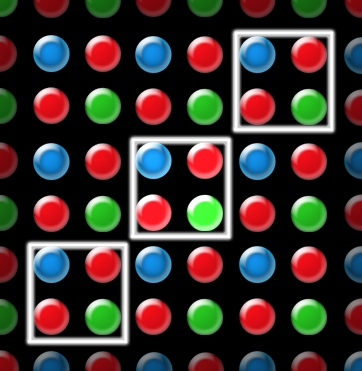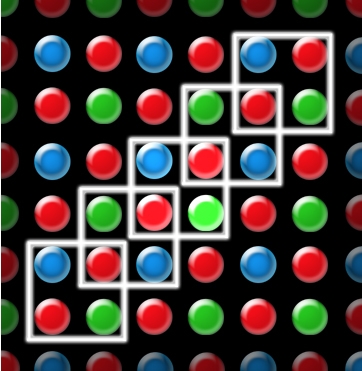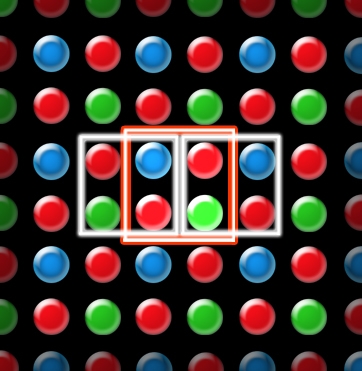| Companies that trade LED screens, to promote their products in a highly competitive market, declare that they use the technology of "Virtual Pixel" that can duplicate or even quadruple the effective resolution of a screen. For example, a graphic definiton of "real" 320x240 pixels, in fact, is it converted into an LED screen that can generate "virtual" definition of 640x480 pixels (or a 20 mm pitch screen with normally 2500 pixels per square metre can reach 10000 virtual pixels per square metre). | ||
| Why are the leading developers and manufacturers of LED Screens making this choice? Let's try to analyze the situation and determine, where and when it makes sense to use the technology of "Virtual Pixel" and when instead it is better to use the technology of "Real Pixel". In traditional fullcolor production, each pixel is composed by a cluster of LEDs with three basic colours (Red, Green, Blue: RGB). Their positioning on printed circuit boards is “gathered”, or rather electronically driven as if it was a unique inseparable unit, “pixel to pixel” (Fig. 1). |  | |
 | In the “Virtual Pixel” technology – “Square Pixel”, so called by Tecnovision - the mounting arrangement is like a “carpet”; diodes are the same distance from one another, placed in an alternate and crossed way, and are electronically controlled “LED to LED”. In traditional system each pixel of the image to visualise corresponds to a precise LED grouped cluster on the display. In “Square Pixel” system, thanks to the special configuration of individual LEDs and evolved electronic management characterised by very high refresh rate (500 frames per second), correspondence is not one-to-one any longer but now pixels are created also by using LEDs from adjacent pixels. | |
| Therefore, a "Virtual Pixel" contains information of the 4 pixels of the initial image. This often leads people to think that the screen definition is doubled or resolution quadrupled. Which is not exactly true. Indeed, one pixel on the screen cannot hold and display all the information coming from the initial four pixels. |  | |
| Does “Virtual Pixel” technology have advantages? In general, we can say yes, it does. In several circumstances, the overall quality of the pictures is improved, getting crisper and smoother. This technology gives very good results in terms of color shades, on fragmentary pictures and particularly with live video. | ||





